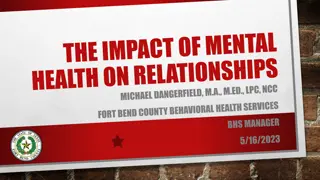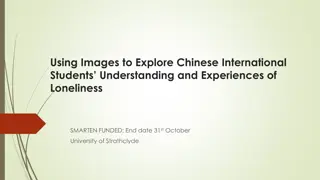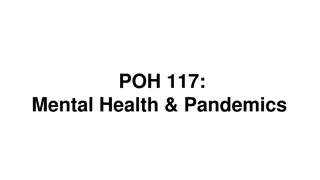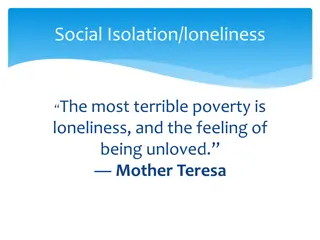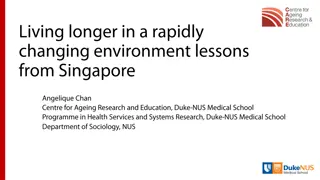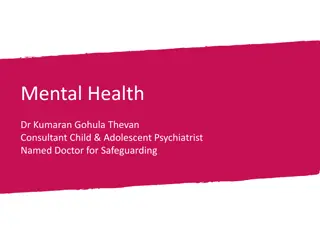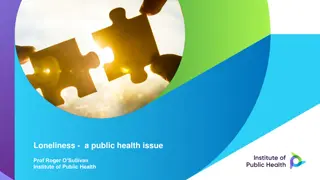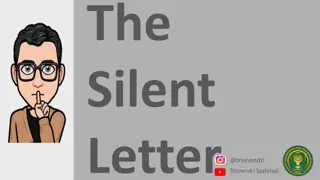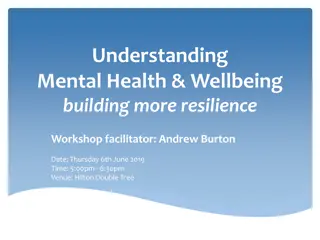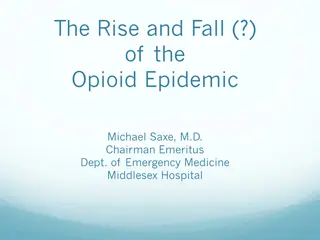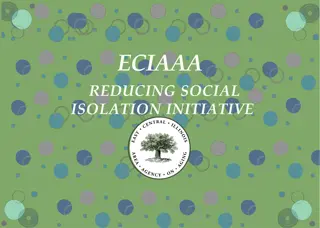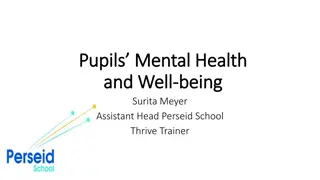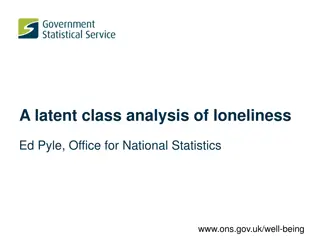The Silent Epidemic: Loneliness and Mental Health
Loneliness is a widespread and growing issue in society, with studies showing its detrimental effects on mental health and even mortality. Younger generations, like Millennials and Gen Z, are particularly vulnerable to feelings of isolation. Despite advancements in various areas of life, the pursuit of happiness remains elusive for many, with the arrival fallacy highlighting that achievement does not always equate to lasting contentment. Understanding the factors influencing subjective well-being, such as genetics, circumstances, and habits like relationships and faith, is crucial in addressing the loneliness epidemic.
Download Presentation

Please find below an Image/Link to download the presentation.
The content on the website is provided AS IS for your information and personal use only. It may not be sold, licensed, or shared on other websites without obtaining consent from the author.If you encounter any issues during the download, it is possible that the publisher has removed the file from their server.
You are allowed to download the files provided on this website for personal or commercial use, subject to the condition that they are used lawfully. All files are the property of their respective owners.
The content on the website is provided AS IS for your information and personal use only. It may not be sold, licensed, or shared on other websites without obtaining consent from the author.
E N D
Presentation Transcript
Loneliness: The Greatest Threat to Mental Health We Hardly Ever Talk About Pat Love, Ed.D. www.patlove.com
Americans are a lonely loteven before COVID New nationwide survey found loneliness is widespread in the U.S. Nearly 50% of respondents in a 20,000N study Feel alone or left out, always or sometimes 54% said no one knows me well. 56% reported: People are not necessarily with me. I lack companionship. Relationships are not meaningful. I am isolated from others.
Growing evidence that loneliness can kill Robust research links loneliness to premature death Younger generations are lonelier than older generations Generation Z, born between mid-1990 s and early 2000 s had an overall score of 48.3 Millennials, a little older scored 45.3 Boomers scored 38.6
(YouGov) 22 percent of millennials say, They have no friends 27% say they have no close friends 30% say they have no best friends 25% say they have no acquaintances 30% say they feel lonely the highest percentage of all generations surveyed.
John Cacioppo study of US data Loneliness is clearly on the rise! 25% of people are plagued by frequent loneliness AARP study: 35% of those age 45 and up report chronic loneliness. (Compared to 20% only 10 years ago) 29% of married people say they are lonely
Have you heard the term arrival fallacy? The belief that once we make it, reach our goal, arrive at a particular destination, we will reach lasting happiness. The problem is: achievement doesn t equal happiness.
We are pretty good at knowing We are pretty good at knowing What makes us happy What makes us unhappy But not very good at predicting the intensity and duration of the effect of the events. We can be seriously let down after the fact.
Subjective well-being Genes about 50% Circumstances maybe 10% Habits 40% Habits include faith, relationships, work
Social isolation correlates with an increase in aggression and violent crime
Incel: a portmanteau of involuntary celebate A member of an online subculture who define themselves as unable to find a romantic or sexual partner despite desiring one. Incel online forums often characterized by anger, resentment, misognyny, misanthropy, self-pity, racism, and a sense of entitlement to sex. Also endorse violence against sexually active people. Mostly male, heterosexual, predominantly white.
At least SEVEN mass murders resulting in a total of 46 deaths, have been committed since 2014 by men who have either self-identified as incels, or have posted incel writings online
loneliness correlates with substance abuse emotional problems
Loneliness also correlates with Depression Sleep disorders Chronic pain Anxiety Compromised immune system Inadequate self care Materialism
Prolonged loneliness can be as harmful to you as smoking obesity high blood pressure lack of exercise
Communicating solely through technology Robs us of richer neurological effects of in-person interactions Which alleviates loneliness As well as anxiety As well as depression
Only a few generations ago We spent most of our time outdoors Sunlight boosts serotonin Prefects SAD Regulates the body s internal clock and sleep patterns Today we spend 93% of our time inside.
Loneliness can result in languishinga common state during the pandemic A sense of stagnation and emptiness It s the state between depression and flourishing It s the absence of well-being You are not functioning at full capacity Your motivation is dulled Your ability to focus is diminished More common than depression
Loneliness is a detriment to our subjective well-being J of Happiness Studies Subjective wellbeing= genes+circumstances+habits
Which habits? Habits= faith+family+friends+work Faith doesn t mean religion necessarily; more about finding meaning in life as well as a way to be other than self-focused Family means intentional and biological/legal Quality and quantity time with friends and family Meaningful work
Technology exacerbates loneliness with the illusion of relationships Pining away in the land of a thousand friends Anthropologists tell us our evolutionary structure limits us to 150 meaningful relationships at a time Technology hasn t changed this 5 intimate bonds 15 close friends 50 friends you would invite to an important event
The virtual world The virtual world Affordable Accessible Anonymous Addictive
Internet has created an additional way to cheat in relationships Emotional Financial Sexual/explicit behaviors Solitary behaviors Technology/online behaviors Q: Are there at risk individuals who would not cheat if the Internet were not available?
Jean Twenge, Ph.D. professor of Psychology San Diego State University Generation Me: Why Today's Young Americans Are More Confident, Assertive, Entitled and More Miserable Than Ever Before The Narcissism Epidemic: Living in the Age of Entitlement iGen: Why Today's Super-Connected Kids Are Growing Up Less Rebellious, More Tolerant, Less Happy -- and Completely Unprepared for Adulthood (August 22, 2017)
iGen: born between 1995 and 2012 They have more leisure time (less homework, fewer have jobs) More time on social media Time with friends has dropped 40% between 2000 and 2015 On the brink of the worst mental-health crisis in decades. Direct link to phone use Teens with more time than average on screen are more unhappy Teens with more time than average on nonscreen activities happier All screen activities are linked to less happiness; all nonscreen activities linking to more happiness (even homework)
iGen data Lonely Dislocated Depressed heavy users of social media increase depression 27% Sports, religious services, volunteer work, hobbies increase happiness; prevent depression Teens who spend 3 hrs a day or more on electronic devices are 35% more likely to have a risk factor for suicide, such as making a plan.
Centers for Disease Control and Prevention In 1999 the death rate for children 10-14 from car crashes was quadruple the rate for suicide. In 2014 car crashes went down by 58%, but suicide rates were doubled. Social media magnifies challenges and insecurities of preteens. If something gets said that is hurtful or humiliating, it s not just the child who said it who knows, it is the entire school or class!
iGen date continued Social media exacerbates concern of being left out Especially hard on girls Boys depressive symptoms increased 21% from 2012 to 2015 Girls depressive symptoms increased by 50%! Rise in suicide in girls is pronounced.
Dire consequences Girls are more likely to experience cyberbullying Boys tend to bully each other in person Girls undermine other girls social status Middle and high-school girls: Ostracize Exclude Send hateful messages Death threats Spread lies Pose as the victims and harass others in their names Post humiliating videos of kids they dislike
CyberbullyingThe mean way kids treat each other online 20% of teens say their peers are mostly unkind to each other on social networks. 24% of teens, young adults say someone has written something about them online that wasn t true. 9% say someone has threatened to use electronic communication to tell others private things about them as a form of blackmail.
Predators 76% of predators are 26 years or older. 47% of offenders are 20 years old than their victims. 83% of victims who met their offender face- to-face willingly went somewhere with them.
Heuristic approach to helping heu ris tic hyo o ristik/ adjective: heuristic 1. enabling a person to discover or learn something for themselves. "a hands-on approach to learning"


